Kayaking is an outdoor activity you can take part in from the time you are a kid to well past retirement. No matter when you get started though, one of the best things you can do as a beginner is to find a kayak that will assist in making your early experiences the most enjoyable.
Similar to choosing a bike or a pair of skis, many kayaks look similar, especially if you are new to the sport. As in these other sports, though, kayaks are far from being all the same.
So, what are the best beginner kayaks? It’s easy to equate a cheap kayak as a good beginner kayak, but this isn’t necessarily the case. Sometimes, a cheap kayak is just a cheap kayak. It is though a great idea to consider a reasonable price for your first boat and to look at what makes a sound choice within your budget. And, above all else, the right kayak to get started should be one appropriate for the type of waterways and paddling you intend to do.
To guide aspiring kayakers, here are my opinions for some of the top options available in various categories. For the boats listed here, there are likely other designs you’ll enjoy. The purpose of these selections is as much to illustrate what makes these great kayaks for beginners so you can consider those details as you browse boats available to you.
The best beginner kayaks for 2025: Our top picks
Best beginner kayak overall
Eddyline Caribbean
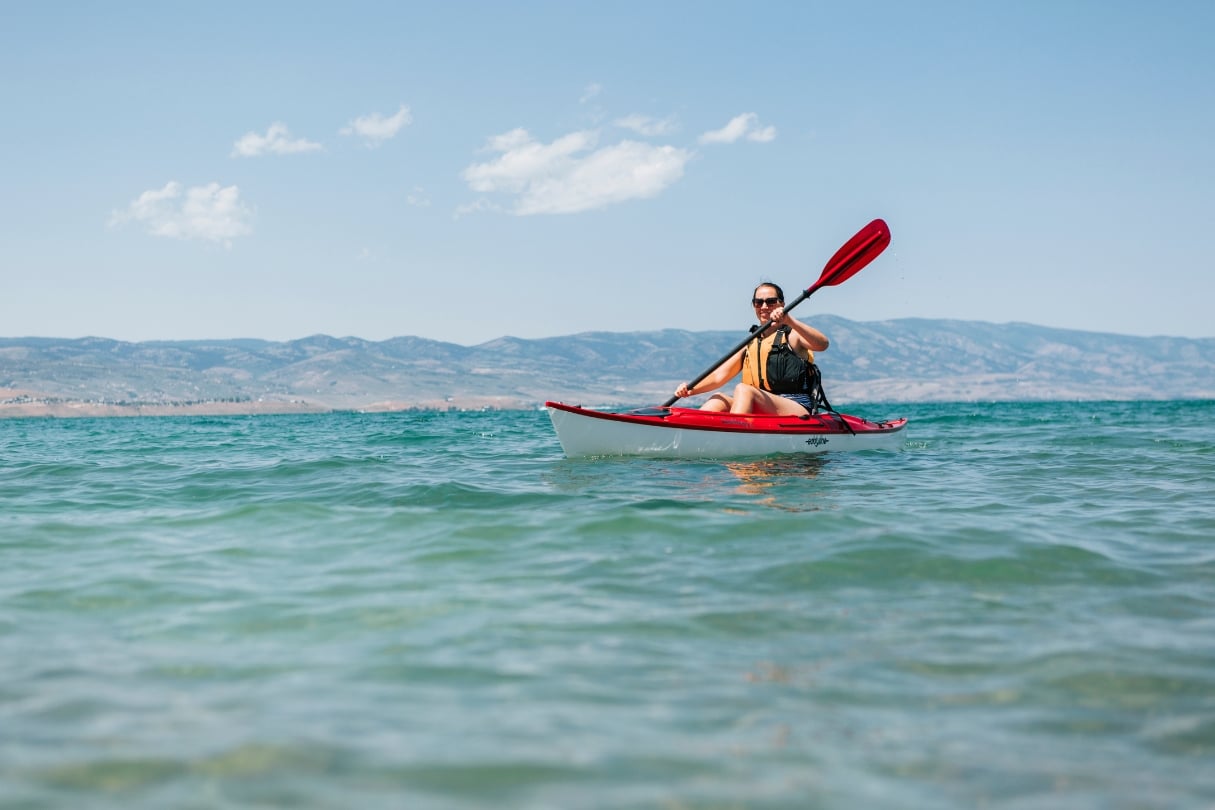
Eddyline Caribbean Specs
Sizes / Models: 10 | 12
Length: 10’ | 12′
Width: 29” | 30″
Weight: 39 lbs | 45 lbs
Capacity: 200 lbs | 275 lbs
MSRP: $1,149 | $1,699
eddyline.com
Buy from:
Why I love it
The term recreational kayak is often used to describe shorter kayaks, built for sheltered and slow-moving waterways and covering short distances. They tend to be wider and prioritize what’s measured as initial stability—the ability to sit flat on the water—over speed. This makes them a popular choice for a large number of kayakers who just want to take casual outings. A recreational kayaker also values a boat that is comfortable to sit in for up to a few hours, and can be carried to the water with minimal effort. With the Caribbean series, Eddyline has put together an exceptional sit-on-top design for beginner recreational kayakers which manages to put together all the above as well as pull beneficial attributes from sit-inside kayaks.
The Caribbean 10 and 12 models should be looked at not only as separate sizes but slightly different intentions. Think of the Caribbean 10 as the premium version of the cheaper sit-on kayaks you see at a big retail store. It focuses on stability and having a relaxed day on the water with much better outfitting and construction. It has a V-hull design to help track in a straighter path while still having a shorter length allowing it to turn with relative ease. Even with its features, the Caribbean 10 maintains an approachable price. The Caribbean 12 is elongated and great for someone who is a beginner bent on covering some distance, seeking a higher maximum capacity, or who paddles somewhere where wind and a little chop are common factors to cut through.
Sit-on-top recreational kayaks aren’t known for speed. The wide hull shapes tend to be slower with the focus on being stable. A major aspect of what makes the Caribbean unique though is its ability to remain stable while having an efficient hull, which is slightly narrower than most, and tapers at the bow and stern to cut through the water with ease.
One of my favorite aspects of the Caribbean series is also how lightweight they are for sit-on-tops. They are able to accomplish this in production with thermoformed sheets of plastic rather than rotomolded plastic. The 10-foot Caribbean weighs just 39 pounds—around 15 pounds lighter than the similar-sized Old Town Malibu mentioned below. This weight savings and a good carry handle go a long way in making it more manageable to get your kayak to and from the water.
One last aspect of a beginner recreational kayak which shouldn’t be overlooked is the fact a sit-on-top is easier to get in and out of, especially in the event of a capsize.
People who choose sit-insides tend to do so for certain design preferences including hull shape and lighter weight, but with the Caribbean, Eddyline has produced a sit-on just as good in many aspects.
Reasons to buy
- Lightweight sit-on-top is less effort to lift and carry
- Comfortable seat
- Good carry handles to reach the water
- Open deck is easy to climb in and out of
- Scupper holes drain water from seating area
- V-hull, tapered bow and stern, and hull width provide both stability and glide
- Cost of the Caribbean 10 is relatively low for a premium kayak brand
Consider another if
- Your budget needs to remain below $1000
- You want an enclosed boat
- You are seeking a more specialized kayak for long stretches of open water or whitewater rivers
Bottom line
The Caribbean is a top tier recreational kayak for beginners and all abilities.
Best Budget-friendly sit-on-top for beginners
Old Town Malibu
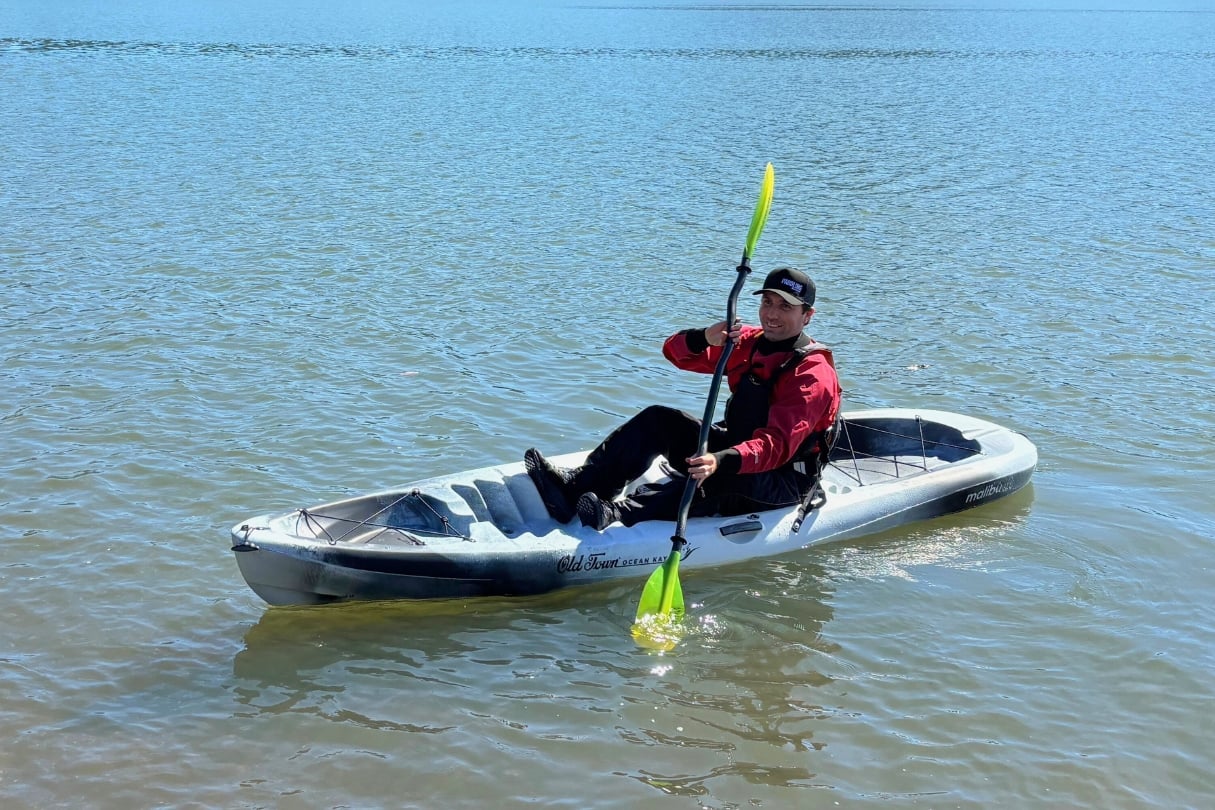
Old Town Malibu Specs
Sizes / Models: 9.5 | 11.5
Length: 9’5” | 11’5”
Width: 33” | 31”
Weight: 54 lbs | 61 lbs
Capacity: 271 lbs | 299 lbs
MSRP: $699.99 | $799.99
oldtownwatercraft.com
Buy from:
OLD TOWN AMAZON REI BACKCOUNTRY
Why I love it
Something to notice about a list of boats on this list is the presence of time-tested designs. The Old Town Malibu is no exception. The Malibu is ubiquitous, often stacked at kayak rental outposts along sandy beaches and boat launches. The reason is because for years the Malibu has been both a reliable and affordable option offered by a storied paddlesports brand. The Malibu is also available at stores across the country.
The Malibu series is another sit-on-top design, making it easy to climb in and out of. The Malibu has a wide, multi-hull design to provide the initial stability people seek in a recreational kayak. If you look at the profile, it also has a rockered bow that curves upward. This is great for busting through chop, or having some fun surfing small waves. The profile also includes a prominent keel at the bow and stern to help it track in a straight line and avoid wanting to spin with each stroke. The shape overall provides confidence to paddle in a variety of regularly encountered conditions.
For outfitting, there are molded-in footrests with numerous notches to choose from. The seat is scooped out to feel you are sitting low enough to feel stable, while the backrest provides great support. The backrest is also built-in and elevated, but folds flat and tucks under the rear bungees for transport. I do find the Malibu heavier and awkward to carry distances without a cart or partner to lend a hand, and recommended pulling up close to the launch if possible.
Reasons to buy
- Time-tested design works on a variety of waterways
- Affordable
- Sit-on-top deck is less effort for getting in and out of
- Open deck is easy to climb in and out of
- Scupper holes drain water from seating area
- Simple and comfortable outfitting
Consider another if
- You need a lightweight boat to carry further to access points
- You need the performance or design benefits of a sit-inside kayak
Bottom line
The Malibu has been around for years. It is trusted by many outfitters running rental fleets and is widely available. It’s fun to paddle and the sticker price falls well within the budget-friendly range.
Best recreational sit-inside kayak for beginners
Wilderness Systems Pungo
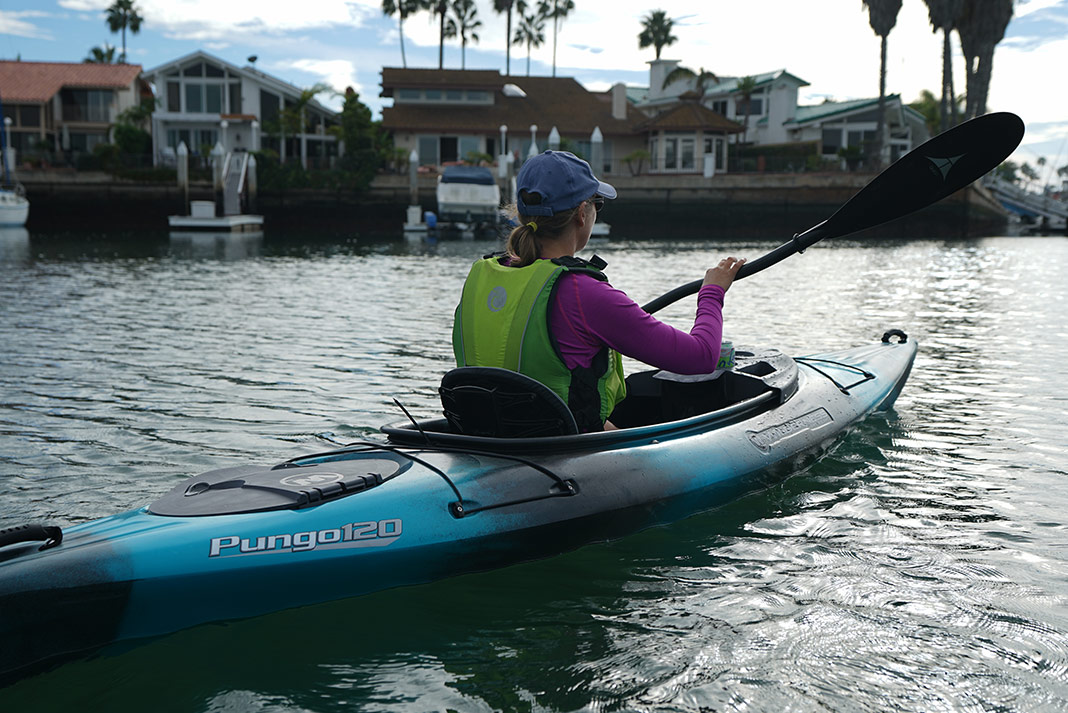
Wilderness Systems Pungo Specs
Sizes / Models: 105 | 120 | 125
Length: 10’6” | 12’2” | 12’6”
Width: 30” | 29” | 29.5”
Weight: 51.5 lbs | 49 lbs | 54 lbs
Capacity: 300 lbs | 325 lbs | 375 lbs
MSRP: $1,119 | $1,219 | $1,219
wildernesssystems.com
Buy from:
WILDERNESS SYSTEMS AMAZON REI SCHEELS
Why I love it
The Pungo is one of the most popular recreational kayaks of the past two decades. Sit-inside kayaks are loved for their sheltered interior seating and hull shape that provides more efficient glide to cover ground. The Pungo is loved for its stability to provide confidence as a kayak for beginners, and its elongated waterline that gives the boat some speed and tracking.
Something you’ll notice with kayak lengths is that shorter kayaks tend to be wider than longer ones. This length-to-width ratio is a good indicator when selecting a size, and deciding whether you want a shorter boat focused on initial stability and easier to turn that is also easier to store and transport, or a longer boat that will provide a faster, more efficient hull that will be slightly narrower. The Pungo provides some of this distinction between the shortest 105 compared with the longer 120 and 125.
The Pungo’s rotomolded plastic construction isn’t the lightest, but it is manageable, and another pro of sit-insides is if needed you can hoist the boat onto your shoulder to reach the water. The Pungo also has a comfortable seat, sliding adjustable foot pegs, a rear hatch to store gear, and a cockpit storage area for need-to-reach items. The dry hatch in the back of the Pungo is also sealed from the inside—thanks to the rear bulkhead. These bulkheads are an important feature for beginners to look for in a sit-inside kayak, as they also act as air filled compartments to keep the kayak buoyant should you capsize.
Reasons to buy
- One of the most popular sit-inside recreational kayak options of the past two decades
- Hull blends stability and efficient paddling
- Available across many outdoor stores
- Comfortable seat and adjustable foot pegs
- Hatch for storage with bulkhead for safety
- Less effort to carry than a sit-on-top
Consider another if
- You’d prefer the ease of getting into and out of a sit-on-top
- You need a sit-inside design dedicated to longer paddling trips or whitewater runs
- You want a lighter thermoformed plastic or composite kayak
Bottom line
If you are in the search for your first sit-inside kayak for recreational use, you can’t go wrong with the Wilderness Systems Pungo.
Best beginner inflatable kayak for kids and adults alike
AIRE Tributary Spud & Tater
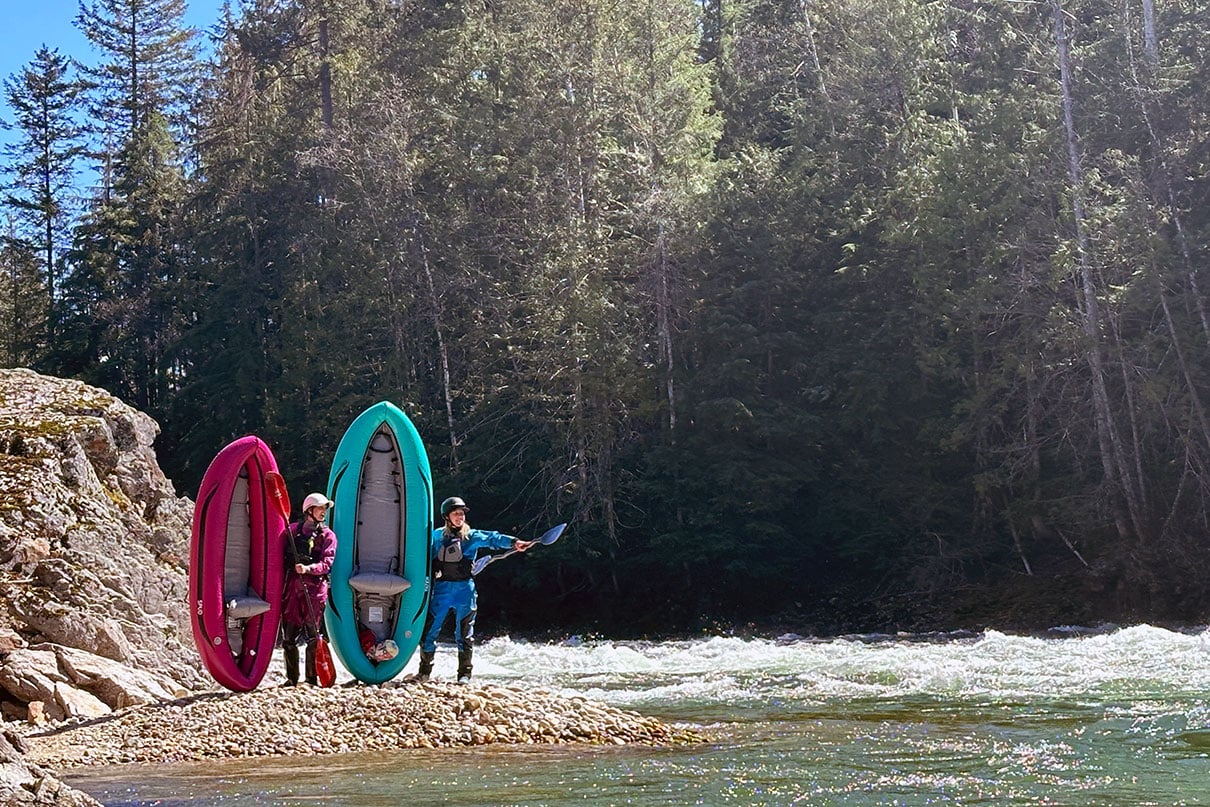
AIRE Spud & Tater Specs
Sizes / Models: Spud | Tater
Length: 7’2” | 8’4”
Width: 35.5” | 38”
Weight: 21.5 lbs | 24.5 lbs
Capacity: 220 lbs | 275 lbs
MSRP: $539 | $699
aire.com
Buy from:
AMAZON BACKCOUNTRY OUTDOORPLAY
Why I love it
Above all, the secret to getting kids into kayaking is to make it fun. with this in mind, the nature of inflatables make them a great place to start for floating rivers and running rapids.
The AIRE Spud and slightly larger Tater, provide buoyant pontoon shaped outer tubes with a deep seating position. On a slow-moving river float, kids can jump in to swim and easily climb back in themselves. Likewise, if they should hit a wave and take a spill in a rapid, the boat size is manageable for them to self-recover.
The all-around forgiveness of these sporty little inflatable kayaks lets your kid enjoy learning paddling technique and reading the river without them having to dive right into the intricacies of edging and rolling. A bonus is that the Spud and Tater are also budget-friendly. All reasons these inflatables have become popular for both kids and grownups getting into river running.
Reasons to buy
- Inflatable kayak design offers a forgiving introduction to kayaking on rivers
- Sporty fun-size feels less barge-like than bigger inflatables
- Durable outer tubes for heavy use and bumping into obstacles
- Low cost for a well-made inflatable
- Not just for kids
Consider another if
- Your paddling destinations are lakes and bays
- Your kid’s whitewater interests involve advanced skills
Bottom line
The Spud and Tater provide one of the most thoughtfully produced options to introduce kids to the world of paddling rivers and make the experience class fun.
Best touring kayak for beginners
Wilderness Systems Tsunami
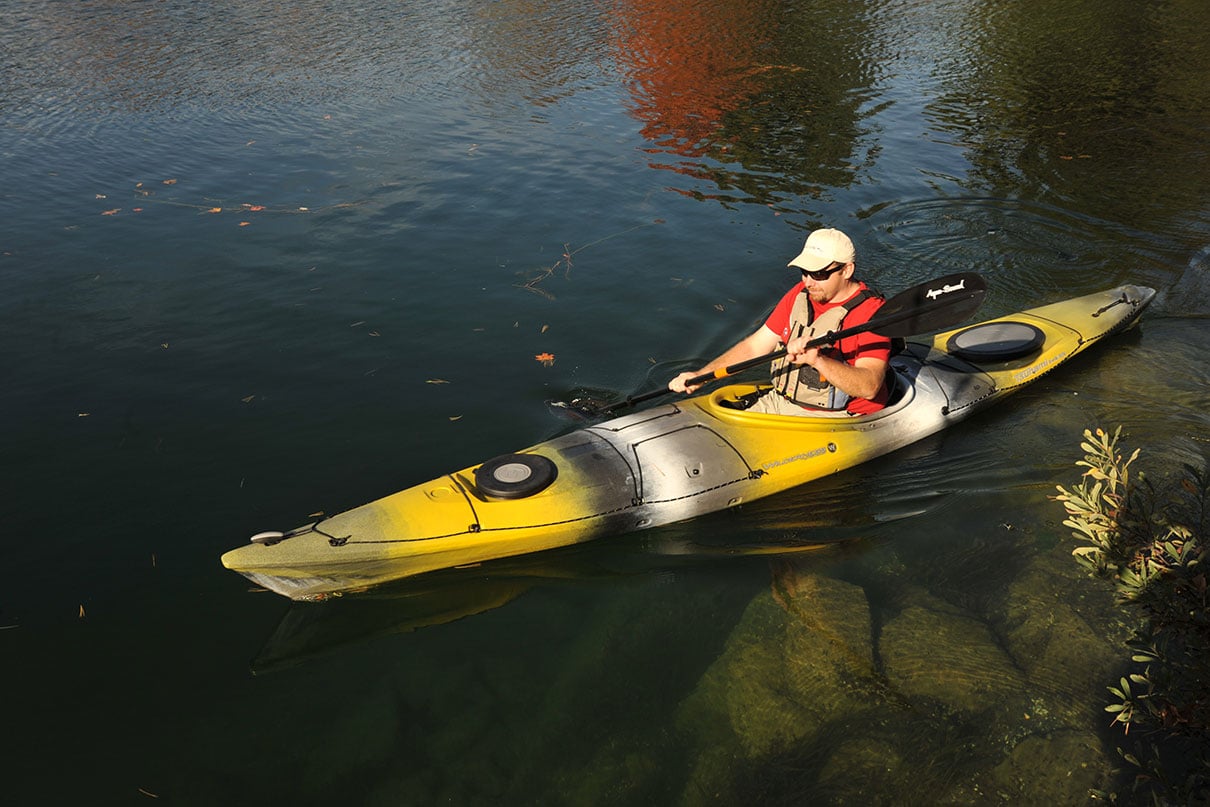
Buy from:
Wilderness Systems Tsunami Specs
Sizes / Models: 125 | 140 | 145
Length: 12’9” | 14’ | 14’6”
Width: 26” | 25.5” | 25.5”
Weight: 54 lbs | 57.5 lbs | 56 lbs
Capacity: 300 lbs | 325 lbs | 350 lbs
MSRP: $1,419 | $1,699 | $1,699
wildernesssystems.com
Why I love it
Like the Pungo in the recreational space, the Wilderness Systems Tsunami has remained one of the most popular touring kayaks since it was introduced in 2004. If you are new to kayaking, and you are looking for a boat with speed to cut through wind and current, cover longer miles on the water, and have the room to store gear for an overnight trip, then the Tsunami is a sound choice. It won’t beat out expensive, high-performance composites, but for those entering the realm of touring it provides a solid learning platform at a reasonable price.
The Tsunami has proven successful at blending the benefits of a recreational kayak’s initial stability with the narrower hull of a touring boat. Contributor Virginia Marshall included the Tsunami on her list of the best touring kayaks. She shared what makes the Tsunami stand out for beginners is that “Plenty of kayaks in the recreational touring market are designed to optimize stability, but many do so by simply offering wider and flatter hulls. The Tsunami pairs a shallow V-hull with flared sidewalls for fearless stability without sabotaging touring efficiency. In other words, it feels very secure without feeling like a barge.”
The Tsunami comes in five sizes. The shorter 125, 140 and 145 are mentioned here as entry-level kayaks for day touring, but you could also consider the longer, narrower two sizes for more ambitious endeavors. Don’t let the term day touring limit your ambitions either though. These smaller Tsunamis have multiple storage hatches and enough space to pack gear for an overnight trip to a nearby island or along the water trail this summer.
Reasons to buy
- Popular introductory touring kayak design since 2004
- Provides the stability to learning without sacrificing the efficiency of a touring hull
- Forward and stern hatches for gear storage
- Mesh deck storage to keep gear and snacks handy
- Comfortable, well-constructed seat and outfitting
- Durable and budget-friendly polyethylene construction
Consider another if
- You are an advanced touring paddler seeking lighter-weight, higher storage capacity, longer, or high-performance oriented kayak
- You plan to paddle short distances on sheltered waters and would prefer the overall comfort of a recreational sit-on-top or sit-inside kayak
Bottom line
If you are new to touring, the Tsunami is a proven ship to take you miles beyond the boat ramp with confidence.
Best whitewater kayak for beginners
Jackson Flow
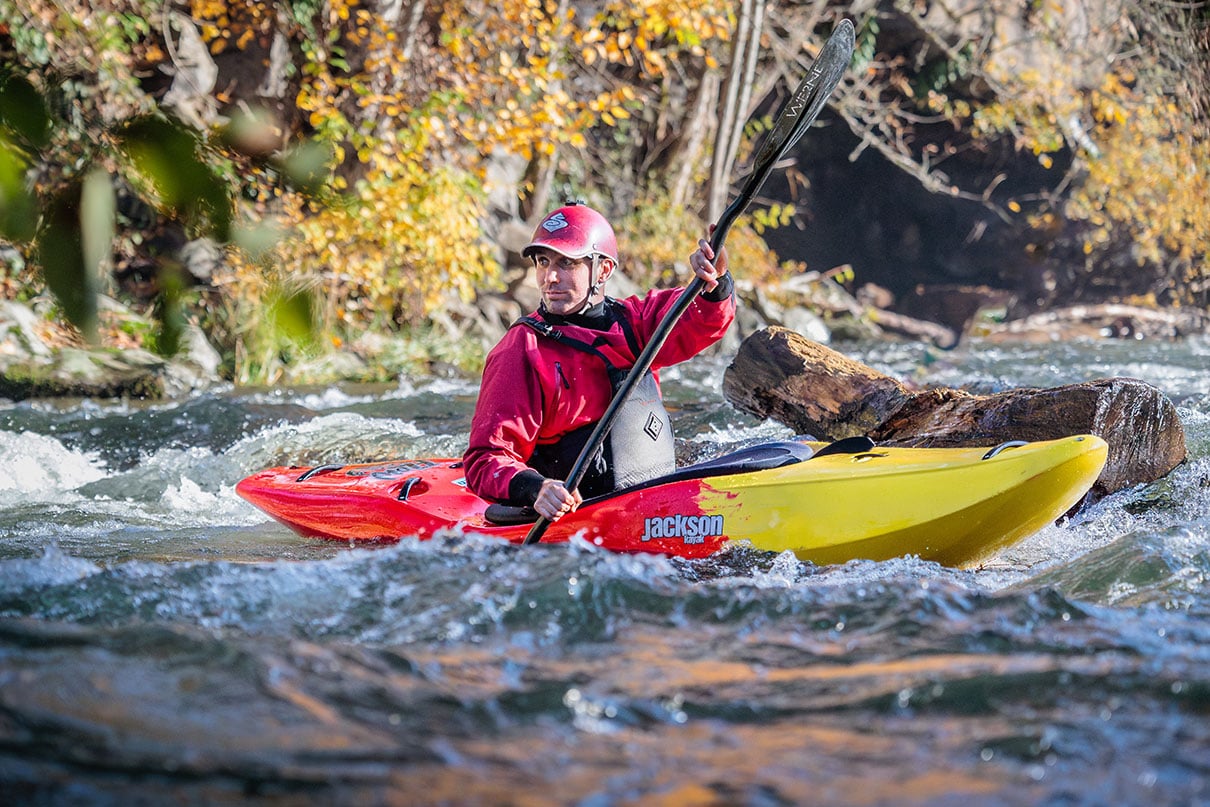
Jackson Flow Specs
Sizes / Models: S | M | L
Length: 8’1” | 8’5” | 8’9”
Width: 26” | 26.75” | 28”
Weight: 44 lbs | 46.76 lbs | 48 lbs
Capacity: 100–170 lbs | 130–190 lbs | 180–260 lbs
MSRP: $1,649
jacksonkayak.com
Buy from:
Why I love it
In a review of the best whitewater kayaks, I included the Jackson Flow as the best all-around. The reason: it’s a whitewater kayak that gives you the tools to learn and continually push your abilities. This is the same reason I’m including it here as the best beginner whitewater kayak. It has the volume, shape, and hull design to to foster unlocking new skills in your introductory years to the sport. As your abilities increase, you’ll find it is a boat you will have fun with on every local river run.
The volume of the kayak centers around the paddler to provide confidence-building stability. The bow and stern have enough rocker to carry you over features. The center of the hull is loose to spin to change course, while the edges are there to dig in for zippy maneuvers.
Jackson Kayak has been producing some of the most beginner-friendly kayak designs since the early 2000s. And it’s not for hull shapes alone. Ingenious outfitting is another reason. When you are a beginner, you want to be able to easily make adjustments to your boat, and in the Flow, you’ll find foot brace, thigh brace, and backband systems you can adjust all while seated in an eddy.
Reasons to buy
- Confidence-building design provides the opportunity to build skills on whitewater
- Easy to adjust outfitting so you can figure out what works where on the fly
- A kayak you’ll still enjoy as your abilities develop
Consider another if
- You plan to paddle a mix of rivers and flatwater and the biggest whitewater you’ll encounter is Class I or II
- You are experienced and seeking a whitewater boat for a specific niche of the sport
Bottom line
The Flow fosters skill building in new whitewater paddlers.
Beginner kayak buying advice
The best way to pick a kayak you will enjoy as a beginner is to choose a boat that will be most helpful in enjoying your time on the water. This means weighing what type of paddling you are trying to do, understanding your experience level, and getting an idea of what the kayaks you are considering offer. It’s always best to spend a little time in a kayak before buying it, but if that isn’t an option, consider how it compares with specifications and purpose with models mentioned above.
With these points in mind, it’s especially helpful to learn about the different types of kayaks, meaning the various category names the industry has given them such as recreational, touring and whitewater. These names are meant to help catalog the types of waterways and use they are appropriate for.
Once you have an idea of the type of kayak use you are searching for, you can also consider whether you would prefer a sit-on-top or sit-inside kayak and the various types of hull shapes and their benefits.
Considering comfort and self-recovery
After years teaching people how to kayak I find there are also two often overlook factors to consider when buying your first kayak:
- Is it comfortable?
- Can you get back in it should you capsize?
Comfort has much to say
Comfort tells you multiple things. Many kayaks have adjustable outfitting you want to slide into a position that feel secure and comfortable. However, if you’ve spent time making adjustments, and sitting in the kayak after a few minutes or less than an hour is uncomfortable, it can be a sign the kayak may not be the right size for you, the kayak’s outfitting isn’t very good, or in a best case scenario, you need help tuning the outfitting. Even if it just means sitting in the kayak at the store, take a minute to figure out whether you are going to enjoy spending time in the thing.
A kayak can also feel extremely uncomfortable in another way if you are fighting to stay upright on the water. This is a sign the kayak is may be the wrong size, is not designed for your experience level, or it could just be a poorly designed kayak. You won’t be having fun if you feel like you are on the verge of flipping the whole time.
These are good reasons I’d recommend visiting a paddling shop or demo event where you can try out kayaks, ask questions, and have someone check the boat is setup for you.
The importance of self-recovery
The second question is one people often overlook. The goal is to stay in the kayak after all. However, the reality is there is always the possibility of capsizing or falling out. If you are out on a lake, or a moving river or tidal area, and you flip and are unable to self-recover, you put yourself in a dangerous situation.
This is one reason sit-on-tops are a good choice for beginners. They are much easier to climb back into, and, if the plugs and hatches are closed, they take on very little water.
If you choose a sit-inside kayak, you should know the steps to self-rescue, and, at the least, be sure you have a kayak with an interior bulkhead which creates a sealed compartment to keep it buoyant while you work out your recovery. If you do have a kayak without bulkheads, floatbags are available to buy and easily add inside the kayak to provide this type of air chamber.
There are plenty of other details you could dive into for choosing your first kayak, but if you can answer whether it is comfortable to sit in and paddle, and if you can self-recover with it, then you have a great starting point to enjoy kayaking.
Best beginner kayak brands
- Wilderness Systems
- Perception
- Advanced Elements
- Pelican
- Eddyline Kayaks
- Delta Kayaks
- Vibe Kayaks
- AIRE
- Sea Eagle
- Old Town
- Ocean Kayaks
- Jackson Kayak
- Pyranha Kayaks
- Dagger Kayaks
How we tested
The kayaks in this article were chosen through recent years of field testing experience with numerous models, as well as with the input of our contributors through extensive boat reviews.




